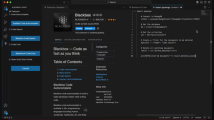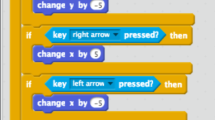Abstract
The main argument promoted in this paper is that computer programming is a cognitively challenging subject and hence good instructional strategies are important in providing the student with optimal learner support. This paper examines some of the major issues in the instruction of computer programming as based on du Boulay’s 1989 framework. For each area of difficulty, some potential solutions are proposed. Solutions are categorized as pedagogical, technological or content based. An attempt is then made to combine these potential solutions and best practices as found in the literature into a learning environment CABLE.
Access this chapter
Tax calculation will be finalised at checkout
Purchases are for personal use only
Preview
Unable to display preview. Download preview PDF.
Similar content being viewed by others
References
O.Astrachan, & T. Selby ,J. Unger , An Object-Oriented, Apprenticeship Approach to Data Structures using Simulation , paper in proceedings of FIE ’96, Frontiers in Education, 2006
S.Garner, Cognitive Load Reduction in Problem Solving Domains, Edith Cowan University, 2000.
AECT 2001. The handbook of Research for Educational Communications and Technology. In URL: http://www.aect.org/intranet/publications/edtech/24/24-05.html [accessed June 12th 2003]
D.G.Moursound, Increasing your expertise as a problem solver: Some roles of computers. Eugene, OR: ISTE. Copyright (C) David Moursund 2002.
W.Au, Logo programming: Problem solving and instructional methods. Unpublished doctoral dissertation. Palmerston North, New Zealand: Massey University, 1999.
A. Blair. amp; T. Hume.T.An Exploration of the Application of Constructive learning Techniques to Software development using Object orientation as a Vehicle. Paper, presented at CTI Annual Conference, 1994. In URL : http://www.ulst.ac.uk/cticomp/therhume.html, retrieved March 12th , 2003
J.Tholander., K. Karlgren, R.Ramberg, Cognitive Apprenticeship in Training for Conceptual Modeling, 1998 in URL[http://www.dsv.su.se/∼klas/Publications/webnet98.pdf] accessed July 15th 2003
J.B.H. du Boulay, Some difficulties of learning to program. In E. Soloway and J.C. Spohrer, (Eds.), Studying the Novice Programmer (pp. 431-436) Hillsdale: Lawrence Erlbaum Associates, 1989.
A. Blackwell, What is programming? In J. Kuljis, L. Baldwin & R. Scoble (Eds.), Proceedings of the 14th Workshop of the Psychology of Programming Interest Group,Brunel University, June 2002. Retrieved April 4th, 2005 from http:// www.ppig.org.
M. Kolling, M.. The problem of teaching object-oriented programming. Part II: Environments, 1999.Retrieved November 20, 2004, from http://www.mip.ou.dk/~mik/papers/oo-environments.pdf.
J. F. Pane, & B.A.,Myers, Usability Issues in the Design of Novice Programming system, Carnegie Mellon University, School of Computer Science Technical Report CMU-CS-96-132, Pittsburgh, PA, August 1996.
A. Robins, J, Rountree, & N. Rountree, N. Learning and teaching programming: A review and discussion. Computer Science Education, 13(2),137–172., 2003
H. Balzert, E-Learning Platform, W3L, Wirtschaftsinformatik 46, 128/129, 20-31, 2004.
Rist, R. S. (1995). Program Structure and Design. Cognitive Science, 19, 507-562.
Lui, A. K., & Kwan, R., Poon, M., & Cheung, Y. H. Y. (2004). Saving Weak Programming Students: Applying Constructivism in a First Programming Course. SIGCE Bulletin, 36(2).
Diethelm, I., Geiger, L., & Zundorf, A. (2005). Teaching Modeling with Objects First. Retrieved July 26th, 2005 from[http://www.se.eecs.uni-kassel.de/se/publications/DGZ05.pdf].
Blackwell, A. (2001). First Steps in Programming: A Rationale for Attention Investment Models. Presented at IEEE Symposia on Human-Centric Computing Languages and Environments. Arlington, VA, 2-10.
Lahtinen, E., Ala-Mutka, K. & Jarvinen, H. M. (2005). A Study of the Difficulties of Novice Programmers: Proceedings of ITiCSE, 2005 (pp. 14 – 18). NewYork NY: ACM.
Brusilovsky, P., Kouchnirenko A., Miller P., & Tomek, I. (1994). Teaching programming to novices: A review of approaches and tools. In T.Ottman, I. Tomek (Eds.) Proceedings of ED-MEDIA’94 – World Conference on Educational Multimedia and Hypermedia (pp 103-110). Vancouver, Canada.
L.McIver, Syntactic & Semantic Issues in Introductory Programming education. Unpublished doctoral dissertation, Monash University: Clayton, Victoria, 2001.
D. Sleeman, R.T. Putman, J. Baxter, & L. Kuspa. An introductory Pascal class: A case study of students’ errors. In R. E. Mayer (Ed.) Teaching and learning computer programming (pp 207-235). Hillsdale, NJ: Lawrence Erlbaum Associates, 1988.
T. R. G. Green, M. Petre, & R.K.E. Bellamy, Comprehensibility of Visual and Textual Programs: A Test of Superlativism Against the ‘Match-Mismatch’ Conjecture. Empirical Studies of Programming: Fourth Workshop. (pp. 121-146). Norwood, NJ: Ablex, 1991.
M. Pedroni, Teaching Introductory Programming with the Inverted Curriculum Approach, Diploma thesis, Department Computer Science, ETH Zurich, 2003. [Electronic Version].
R.Bruhn, & P. Burton, Teaching programming in the OOP Era. The SIGCSE Bulletin, 35(2), 111-114, 2003.
J.C. Winnips, Scaffolding by design. A model for www learner support. Unpublished PHD dissertation, University of Twente, 2001.
A.Collins, J.Brown, & A.Holum, Cognitive apprenticeship: Making Thinking Visible, 1991. Retrieved March 20, 2004, from http://www.sapio.org/demo/cognitive_apprenticeship.htm
S. Jarvela, The Cognitive Apprenticeship Model in a Technologically Rich Learning Environment: Interpreting the Learning Interaction. Learning and Instruction 5(3), 237-259, 1995.
J. Levin, & M.Waugh, Teaching teleapprenticeships: Electronic network-based educational frameworks for improving teacher education. Journal of Interactive Learning Environments, 6(1-2), 39-58, 1998.
J.Levin, A 2020 Vision: Education in the next two decades, 2002. Retrieved January 18, 2004, from http://w3.ed.uiuiuc.edu/faculty/J-Levin/2020-vision.html.
I.T. Chan Mow, W.K. Au,and G.Yates, “The impact of the CABLE approach in teaching computer programming” , 2006.
I.T. Chan Mow, W.K. Au,and G.Yates, “The impact of the CABLE approach in teaching computer programming” , 2004
Author information
Authors and Affiliations
Editor information
Editors and Affiliations
Rights and permissions
Copyright information
© 2008 Springer Science+Business Media B.V.
About this paper
Cite this paper
Mow, I.C. (2008). Issues and Difficulties in Teaching Novice Computer Programming. In: Iskander, M. (eds) Innovative Techniques in Instruction Technology, E-learning, E-assessment, and Education. Springer, Dordrecht. https://doi.org/10.1007/978-1-4020-8739-4_36
Download citation
DOI: https://doi.org/10.1007/978-1-4020-8739-4_36
Publisher Name: Springer, Dordrecht
Print ISBN: 978-1-4020-8738-7
Online ISBN: 978-1-4020-8739-4
eBook Packages: Computer ScienceComputer Science (R0)




